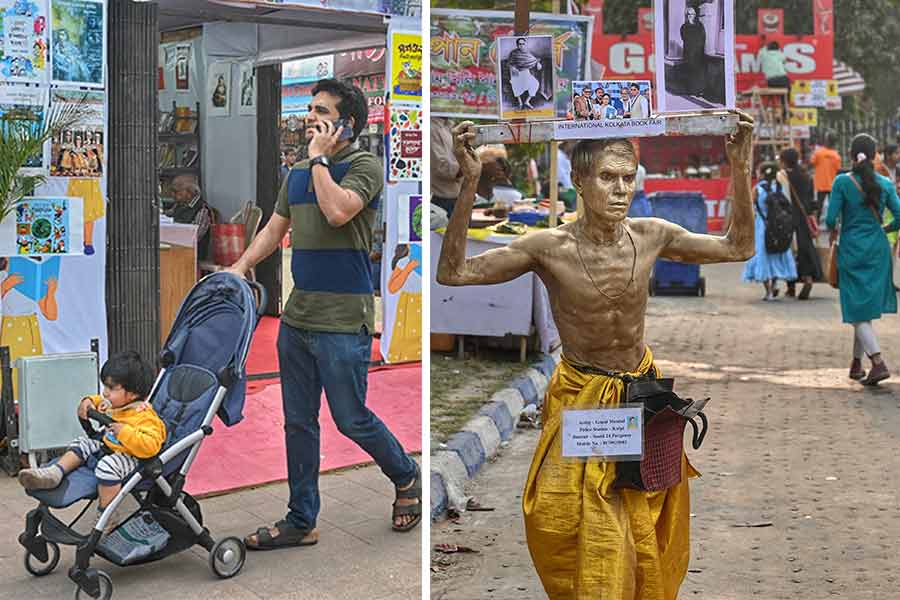 Friday, 31 January 2025
Friday, 31 January 2025
 Friday, 31 January 2025
Friday, 31 January 2025
The illustrations are black-and-white, sty-lised snapshots of Indian life built out of elementary shapes like triangles, circles and squares. Snapshots that look very familiar, very relatable. A large and voluble family gathered around the dining table. An old man havinghis dinner on the sofa while watching television. A family cooking toge-ther and the kitchen mayhem. People squeezed up together in a train. The cooking and eating around Durga Puja.
The book Chhaunk is by Nobel laureate Abhijit Banerjee and the illustrations are by Cheyenne Olivier. Chhaunk contains recipes, but it isn’t a recipe book. It is a bit about food, a bit about the stories behind food, and it gives the reader plenty of food for thought too.
But why call it Chhaunk? “I thought it was a good fit. It is short, sharp and piquant,” says Banerjee.
Chhaunk is the Hindi word for tempering. But perhaps a more interesting word is the Bengali equivalent phoron. Cleverly used it can also mean to comment — phoron kata. In Chhaunk, the articles are commentaries on a variety of things. On India having the lowest participation of women in the workforce. On the number of the elderly living alone in the country doubling between 2000 and 2010. On the point of gift-giving. On Indians spending nearly a billion dollars on biscuits in a year.
It talks of big ideas like Marx’s concept of capitalism and also about koshari, khichdi’s Egyptian cousin. It talks about Indian-Chinese food and the varied regions in China, of Ramzan and the bonding power of shared meals.
Going by the book, Banerjee enjoys cooking, especially with his children. And what do meals look like in the Banerjee home? “Indian, Chinese, Italian and Mediterranean. Sometimes, once in a while, it can be French or Thai or Vietnamese.”
Olivier lives in the Basque region, which is famous for its seafood and Bayonne ham, except that she is a vegetarian. She too likes to experiment with food. “I like to add Indian spices to French dishes. Sometimes it works very well. Sometimes... it doesn’t,” she says with a laugh.
Olivier spent the pandemic-enforced lockdown in Banerjee’s home in Cambridge in the US, lookingafter his children. It was when her collaboration with Banerjee began, first in the kitchen and then on a book, Cooking to Save My Life, Banerjee’s first ever cookbook. They enjoyed the process so much that they continued their collaboration over the last couple of years when Olivier was in France looking after her ailing father.
“We have a rolling list of topics we want to work on,” says Banerjee. Getting into the specifics, it takesBanerjee about a day to write anarticle and then he sends it to Olivier for feedback. “She makes sure it is not too academic or too dry,” hecontinues while she explains that she does not believe in dumbing down the articles either. Once they agree on it, Olivier comes up with a sketch to match.
Chhaunk is an attempt to introduce people to various aspects of economics through food, says Banerjee. But it is not restricted just to topics of interest to economists, points out Olivier. Perhaps it is more correct to say the book discusses topics of social science? Banerjee agrees. “It usually deals with topics on the fringes of what I know,” he adds.
“I think of a meal like an economist thinks about most things: how does one get to a specific objective (impressing/indulging/comforting/nourishing a particular person or group of people) with minimum time and hard work?” reads the author’s note in Chhaunk. Banerjee tells The Telegraph over an hour-long Zoom call from his home in Cambridge, Massachusetts, eating is never about picking the cheapest nutritious meal — as economic theory would predict — “there is always an amount of pleasure involved”. Yes, the budget is a deciding factor but people, rich or poor, manage to make meals pleasing to the palate too. “Money is not the only constraint, there is also the constraint of time, of availability. “Their books have always been about cooking within set limits,” adds Olivier, making it clear that these two collaborators are very much on the same page.
Banerjee talks about the consciousness of scarcity that influences his cooking, about how he likes to use every part of a vegetable. Isn’t that a very Bengali... okay, Indian thing? Banerjee acknowledges the point and tells Olivier about lauer khosha bhaja, posto diye alur khosha bhaja — stir-fried bottle gourd peels, potato peels sauteed with poppy seeds. Olivier points out that the West has a term for it too, zero-waste cooking. “We can call it sustainable cooking,” she says, maximising fresh produce, optimising fuel use. One cannot help but remember the recipe for the Bengali comfort food bhaate bhaat in the chapter titled “Energy Efficient Eating”. Except that instead of the typical boiled eggs and potatoes mashed with a drizzle of mustard oil, Banerjee has advocated mashed sweet potatoes with quartered grapes, toasted walnuts and olive oil and halved boiled eggs topped with a tomato relish. Paired with amaranth leaves — laal saag — flavoured with curry leaves, freshly grated coconut and boiled broad beans dressed in mustard paste.
That is not bhaate bhaat. It is a four-course fusion meal.
Optimisation indeed!







